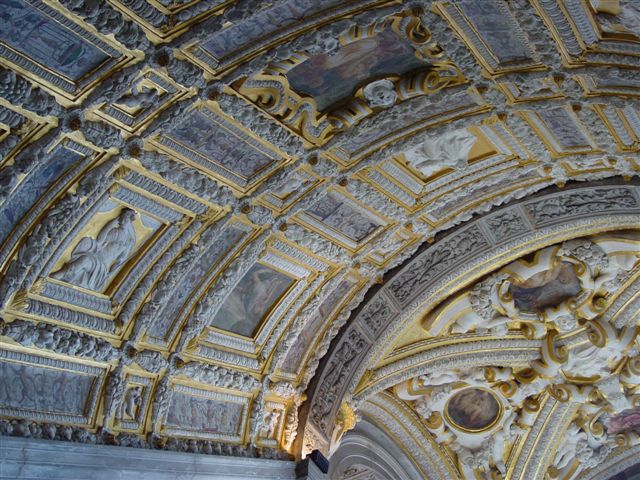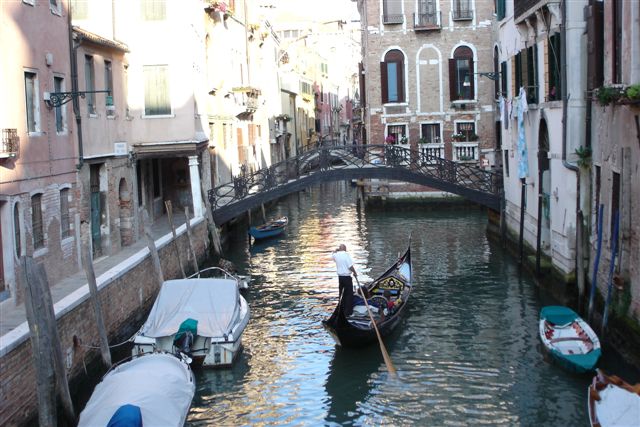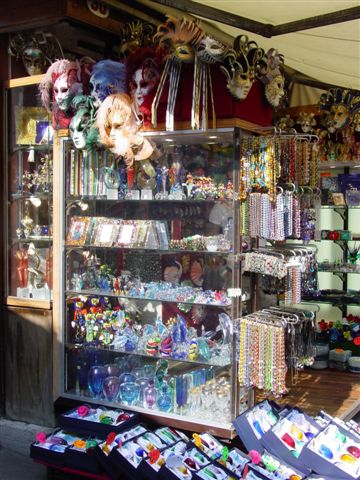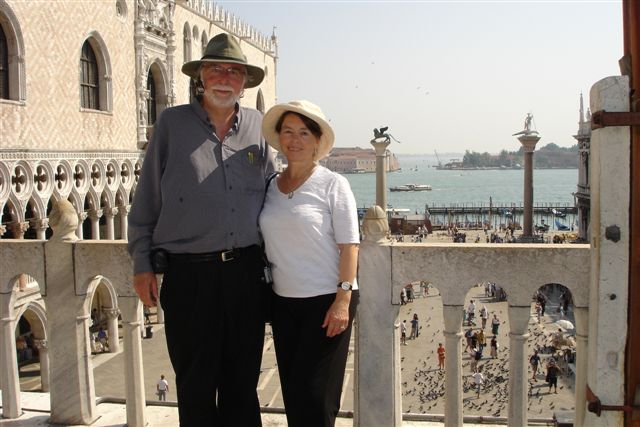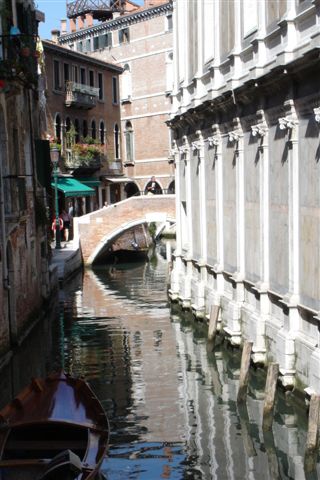
Five Days in Venice
September, 2005
A ninety-minute Easyjet flight, which costs almost nothing, took us from London Gatwick to Venice, where walking from an airplane to a boat "bus" for transfer into the city kicks off the real beginning of an experience of one of the most unique and fascinating cities in the world. We had joined our friends Elizabeth and Chris, who do this every year, so we could exploit their knowledge, optimize our trip, and, of course, enjoy their company. Since Pauline had never been, and my only trip was over twenty years ago, we would hit the major tourist attractions, while they would explore deeper and mostly just hang out and enjoy being in Venice. And what a magical place Venice is to just hang out in!
There are two choices to get to Venice from the airport, the bus boat, or vaporetto, for about $10 or a taxi (speedboat) for about $40. We decided to begin with the bus and come back with a taxi, since the bus ride, itself, provides a first mini tour around Venice. Everything in Venice moves on water or by foot-taxis, trucks, police, ambulances even hearses; there are no cars in Venice, not even golf cars. Our choice to sit outside on the vaporetto was a good choice, definitely the way to begin a Venice adventure.
Speeding along between wooden poles that marked off a highway of sorts through the Adriatic Sea, the bus passed by a number of islands, slowing down near each to comply with speed limit signs posted along the way. Taxis, which are speedboats, whizzed around us at easily twice our speed, constantly ferrying people, mostly tourists, back and forth from the airport. The taxi drivers, for some reason, always seem to stand up behind the steering wheel, giving the whole show a more dynamic and exciting feel.
Seagulls were perched on about every other pole, watching the scene like highway patrolmen. Just as we passed the last island before Venice, the cemetery, a boat hearse, laden with flowers and a casket, made its way to the island. I would have expected that residents would have been cremated to save space, but apparently not. One thing for sure is that you won’t see a cemetery like this anywhere else.
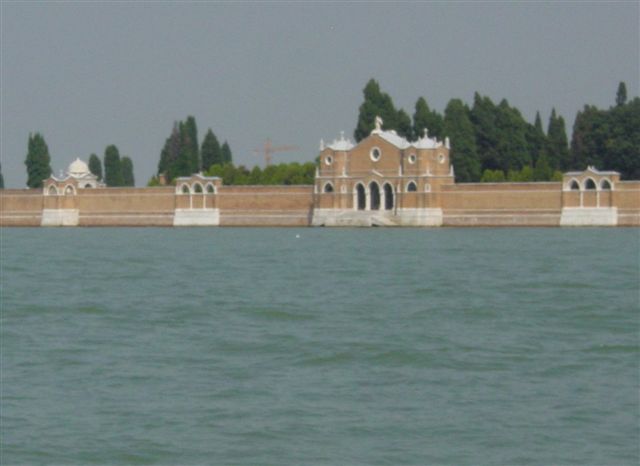
The Venice Cemetery
Our vaporetto made about five stops on its way around the northeast edge of Venice towards San Marco Square, the location nearest our hotel. One of the stops was Murano Island, famous for the production of glass for hundreds of years. One of the reasons for locating the glass industry here was to maintain secrecy of the Venetian production methods. Punishment for disclosing glass making secrets was in some cases death or even worse, so we were told.
We entered Venice from the east at the beginning of the Grand Canal, the largest, busiest, and one of the most beautiful canals in Venice. The Grand Canal cuts Venice roughly in half winding in sort of an s-shape. Looking up the Grand Canal we could see the Campanile at San Marco Square and the Basilica to the right and the Salute church on the left. For me, one of the most obscene views in an ancient European city is a huge tour bus squeezing its way along narrow streets between medieval architecture. At that moment I experienced the Venice equivalent, a huge tourist cruise ship being towed by a tugboat along the Grand Canal. The boat looked so out of place that the entire scene was surreal. I closed my eyes for a few moments as it passed our vaporetto attempting to avoid polluting my first sight of the city.
The 45-minute trip from the airport placed us at San Marko Square. From the drop off point a short walk across the square in front of the Basilica took us to the Hotel Locardo, Remedia, by the Columbina canal just behind the Doges Palace. (The Doge was the chief magistrate of the Republic of Venice, elected by the elders for over 1000 years. He was essentially the shrewdest of the aristocracy.) From our hotel we could see the infamous Bridge of Sighs that passes from the palace to the prison. (More about this later) There are hundreds of small hotels in Venice, and apparently no really large ones. In previous years one was at the mercy of travel agents to select one. Now, with the Internet, you can take a virtual tour of most of them and pick one to suit your needs and budget.
.jpg)
Three tourists entering San Marco Square. To the right is the Doges Palace. In the rear is the Basilica of San Marco. Behind the camera, the WWT.
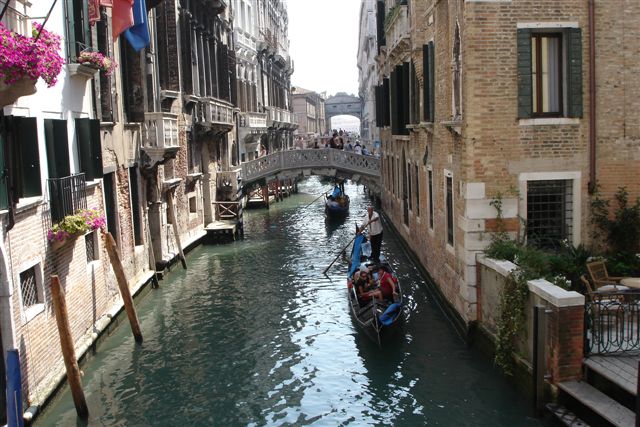
Looking down Columbina Canal. The first bridge goes into our hotel. The elevated bridge at the end of the canal is the Bridge of Sighs. Later, I painted this scene.
After dropping our baggage, we made our way back to San Marco Square where we began our semi-organized exploration of Venice. Observing the surprising shortness of the line into the San Marco Basilica, Pauline and I jumped at the opportunity and went in, while Chris and Elizabeth relaxed on the square and had drinks in one of the large sidewalk cafes. Being flexible has great merits in a tourist-crowded city like Venice. Just simply pass by the places with hour-long waits; there are unlimited places with little or no wait just as good.
Like many churches in Europe, the basilica has become so over run by tourists that the church charges, not only for entry, but also separately for attractions inside, which helps to maintain the church and limit the number of visitors. Venice is probably one of the first cities where it costs five to ten dollars to go in essentially each of the 130 churches on the 100+ islands on which the city is constructed.
Although church entry expenses add up, they are a bargain when one admits that most of us don't go in these places to worship. Pay with enthusiasm, realizing that it keeps the crowds down and provides money to maintain these magnificent places. Otherwise the hundreds of tourists out in the square feeding the pigeons would be packed inside. Vast sums are needed for the constant repair and maintenance required. One doesn’t simply "patch up" a five hundred year old fresco. Just to possess and show a large painting by Titian is an incredibly expensive process, and many of these churches are filled with priceless art works by the greatest masters of medieval and renaissance art, Titian, Giovanni, Lotto, Veronese, Tintoretto, and Belluci. The security in these places has to be a nightmare. Even better, the art in Venice in its original location, unlike most art we see in galleries. Venetian art still performs much the same function for which it was created five or six hundred years ago.
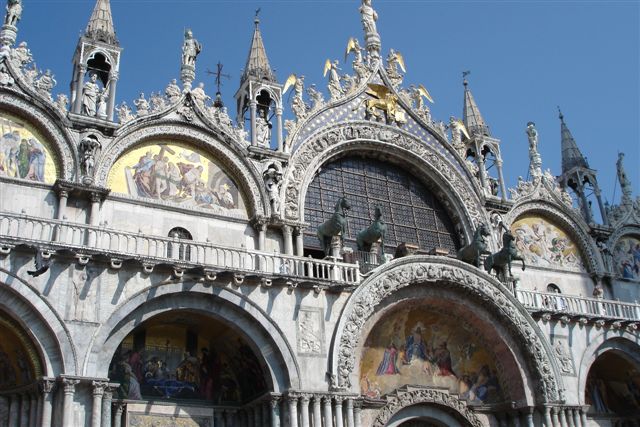
The front of the Basilica San Marco
One must pay three times to see the Basilica San Marco, once to enter the church, again to see the magnificent bejeweled, golden altarpiece, and again to go upstairs through the gallery and out on the balconies. All three are well worth the price. Most of these places have a no-photo policy, not even flashless photos, a policy that is difficult to enforce with the new digital, electronic cameras. Turn off the flash and the sound, hold the camera somewhere in a not so obvious position, fire away, and then later choose a few good ones. You don’t even have to look in the same direction that you are shooting; in fact it is better not to. I only got nailed once while doing this, but I saw many others who were more conspicuous being scolded for the sin.
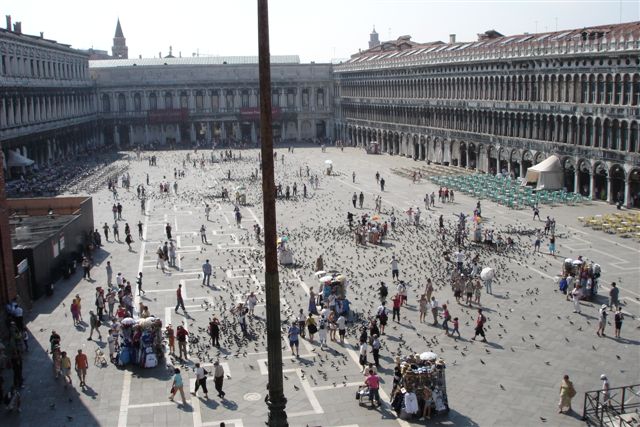
View from the balcony of the Basilica San Marco.
From the balcony of the basilica, we were treated to a nice view of the square below, and what a panorama of beauty! The trip upstairs also provides a better look at the frescos on the basilica walls.
After a couple of hours in the basilica, we rejoined Chris and Elizabeth, who, having downed a few drinks, were happier than ever to be in Venice. At their suggestion, we all took Vaporetto No. 1 up the Grand Canal almost to the other edge of Venice, just past the train station. It is easy to see why people love riding the waterbuses and taxis and gondolas. The trip is a priceless experience, providing one of the most picturesque journeys in the entire world.
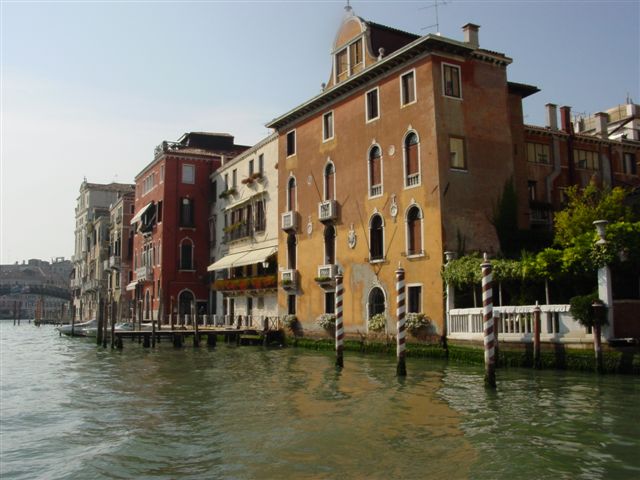
Scene along the Grand Canal taken from the Vaporetto
The bus weaves from side to side, dropping off and picking up new passengers, always remaining packed with people (about fifty per busload). The driver weaves brilliantly in and out of the many other boats on the busy canal, maneuvering quickly with great skill at each dock, while passengers embark and disembark.
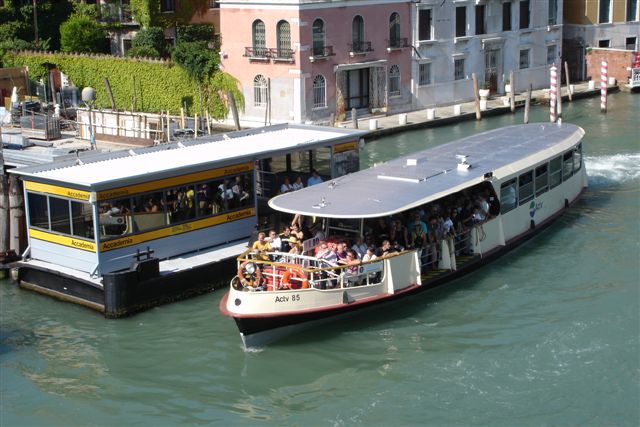
A vaporetto (water bus) leaving a station along the Grand Canal.

The Rialto Bridge over the Grand Canal
It took about an hour to go from San Marco to the train station, with about a dozen stops. By the time we had gone about half way, I had managed to weasel myself into a prime front seat on the outside deck. We disembarked near the train station and hopped on another bus headed back. This time we disembarked at the famous Academia Bridge, a wooden bridge that was intended as a temporary bridge built many years ago. From here we walked back to San Marco Square.
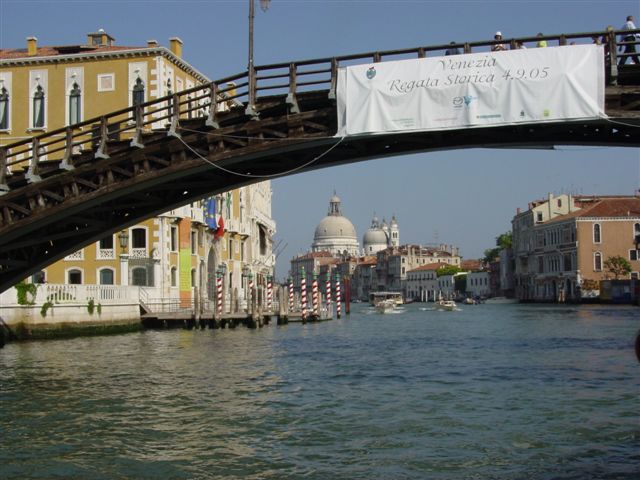
The Academia Bridge over the Grand Canal. Originally intended as a temporary bridge, it has stood for many years, providing a link between two major parts of Venice.
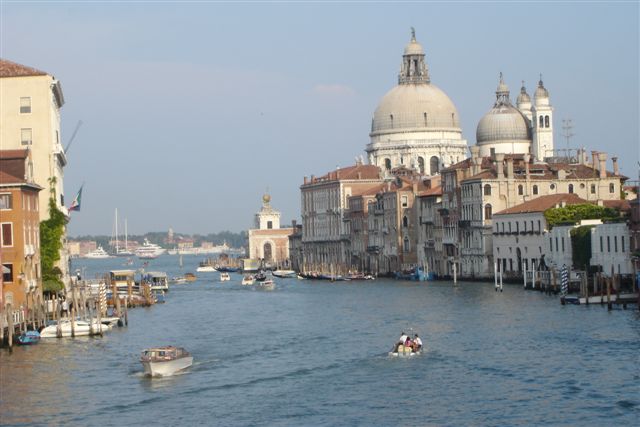
Salute Church taken from the Academia Bridge.
Venice is probably the most fun city in the world to walk in, with the caveat that walking is a very slow process, not only because many streets are narrow and crowded, but because it is impossible to walk along the storefronts without stopping to view the merchandise. Venice, without doubt, has the most unique and beautiful souvenirs of any city in the world. The windows are decorated with such talent that they reach out and grab you, forcing you to look closer and enticing you to purchase. Venice, famous for Murano glass, offers a limitless number of things made from glass, things that are more beautiful than you have ever seen, like pens, pots, puzzles, chess sets, clocks, statues, and so on.
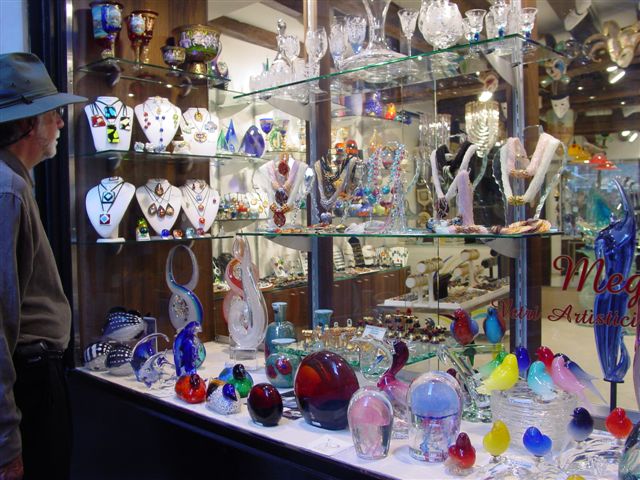
Window Shopping in Venice. Many nice things made of Murano glass. Thousands of beautiful windows entice you right into the stores. (Photo by Pauline Abbott)
Canal beside the Miricoli Church. In this church is a famous painting of the Madonna, which is said to have healing powers. The white marble side of the church makes for a perfect reflection in the canal.
A perfect tourist city, Venice is a money factory for Italy. The absence of cars obviates the parking problem and prevents some peckerhead from driving his car and/or parking in front of the scenery. There are thousands of tiny streets that allow a huge number of people to be packed in without realizing how crowded it really is; tourists outnumber residents by over ten to one. They have a huge variety of different kinds of unique and beautiful "stuff" for tourists to purchase. In a relatively small space there are thousands of interesting and/or beautiful things for tourists to see and do; thousands of bridges, combined with water, reflections, gondolas, old buildings, and flowers, comprise never ending artistic views. Over 100 churches and many galleries provide a never-ending source of beautiful art, some of the most magnificent art in existence. With all due respect to the handicapped, I hope they never surrender to the pressures to equip Venice with complete handicap access and fill the streets with motorized carts. This would destroy the ambiance.
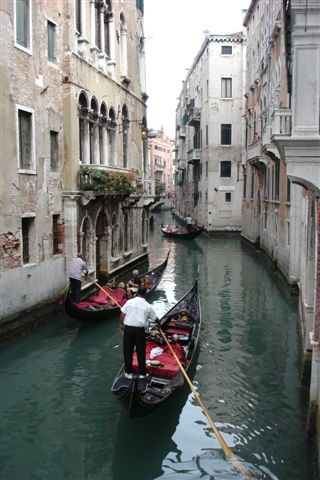
A typical canal and street in Venice. I had a great desire to paint every single one of them.
As the crow flies, it may be 100 meters from Academia Bridge to San Marco Square. It took us over an hour and it seemed like a few minutes. We rested at the hotel and set out again for a late dinner in one of the nearby sidewalk cafes. Venice is not famous for its food, but I was never disappointed, except maybe with the price; Venice is expensive, especially for Americans.
The next day, Saturday, after a full buffet breakfast at the hotel we set out on foot for Rialto Bridge to scout out the shopping. One nice thing about Venice is that one cannot stay lost for long. Signs along the way guide you to the different areas of Venice, like Rialto and San Marco.
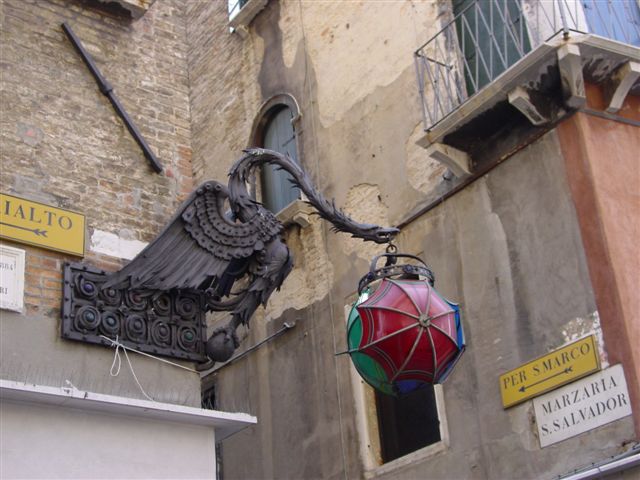
Street corner in Venice. Notice the signs directing you to either Rialto or San Ma (Photo by Pauline Abbott)rco
There is no problem getting money in Venice, with money machines on most of the squares. We found so many tempting things to buy that we elected to delay buying and made our way to the Frari, a church that is the burial place of Titian, unquestionably the most famous Venice master. The church has several huge Titians as well as other great art. It also houses the pyramid monument to Canova, not to be confused with Casanova, who, in addition to being the great lover, was one of the few people to escape from the Doges prison.
Next we moved on to the nearby School of San Rocco, which houses many very large paintings, especially those of Tintoretto, actually a nickname for the painter. The first floor will knock your eyes out, and I was glad it was first, because the second floor is a hundred times better, and had I known, I would probably have just skipped the first floor. Going up the stairs is the first indication of what is to come on the amazing second floor. The second floor ceiling of the school is sometimes called "Tintoretto's Sistine Chapel" because it is covered by many large paintings that Tintoretto produced over a ten-year period. One would get a sore neck looking at the ceiling; however, the school graciously provides large mirrors that one can carry around and view upwards. These paintings are a testimony to Tintoretto's talent and gave me an even greater respect for the master than I had previously.
Tintoretto's talents were recognized at a very early age, and he is said to have studied for brief period under Titian. His father had given him the nickname, meaning "little tinter" because of his artistic ability. The reason for the brevity of his tutelage is cause for various conjectures. One is that Titian was jealous of his abilities. Another is that Tintoretto, being a much faster painter, was bored with Titian's instruction.
The history of controversy over the paintings in the school adds to their interest. Although bids were accepted to produce the work, Tintoretto was given the commission when his bid included a finished painting for one of the large spaces and an offer to perform the service for the cost of materials and whatever the owners wanted to pay him. Wouldn’t it be great if we could all work this way? He worked for the school for the next 30 years for a guaranteed pension. Tintoretto did an enormous amount of work in Venice. His paintings can be seen everywhere. In the Doges palace, he painted "Paradise", the largest oil on canvas painting in the world.
After about two hours in The School of San Rocco, we stopped for a quick lunch, rejoined Chris and Elizabeth and made it to the Salute Church just in time for an organ concert that Elizabeth had discovered in the tourist literature. Elizabeth had actually made friends with this organist on previous visits and visited with her "back stage" after the concert. The Salute is another church where some of the most spectacular work is housed in a separate part of the church, which is well worth the extra entry price.
.jpg)
Inside the Salute Church
From here we took one of the quick cross gondolas that carry you straight across the Grand Canal for about fifty cents. It is said that a real Venetian would never sit down during this crossing. Being an outsider, who had no interest in testing the waters of the Grand Canal, sitting was fine for me.
With the few minutes to spare before our return to the hotel, Pauline and I made a dash back to the shopping district near Rialto and made a few purchases, including a new handbag, some glass angels, and some special art materials. I had observed earlier that the Murano glass pens were made in such a way that they should work perfectly for watercolors and especially for applying a fine line of masking fluid to paper. I had such a difficult time choosing that I ended up purchasing four pens and a small leather bound water color book hand made with special paper from the Amalfi Coast. These books were hand bound by the wife of the man who owns the store, made like the ones artists used here hundreds of years ago, and they came in sizes from very small to very large. I used this leather bound book to paint in during the rest of our Venice stay, and what amazing paper it is for water color. Had I any idea of the quality of the paper, I would have bought a larger book and probably more than one. Loaded down with gifts we headed back to San Marco.

Feeding the pigeons on San Marco Square
We had planned to have coffee and pastries in the famous Florians Café on San Marco Square, but nightfall came with serious rain and we decided to wait for better weather. In the meantime, the Venice movie festival was in full swing and movie stars could be seen entering a red carpet banquet at Doges Palace. Elizabeth and Chris were galvanized by the sight of movie stars and hung out to watch. Pauline and I were more attracted to the idea of getting horizontal for a while and we called it a night.
We got an early start on Sunday and headed for the Doges palace. This palace was intended from the outset to flaunt the wealth of Venice with fine art, sculpture, and architecture, and it continues to impress people in the same way even hundreds of years later. The sculpture, architecture, paintings, and some of the largest rooms in Europe covered with art including ceiling paintings would dazzle both novices and connoisseurs.
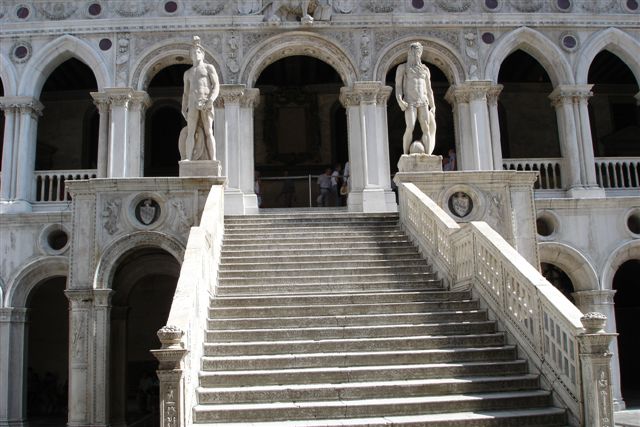
Stairway from the courtyard in the Doges Palace
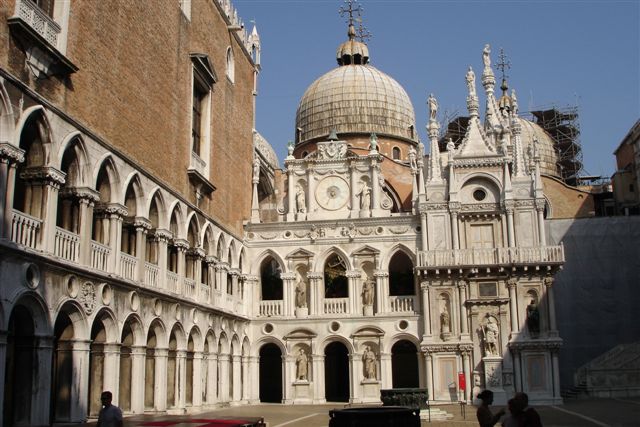
Courtyard of the Doges Palace. The dome in the back is the Basilica of San Marco.
Like many places in Venice, photography is not allowed in the Doges Palace. Fortunately, digital cameras make this rule unenforceable and we recorded a few things of interest. I only got nailed once when I got carried away and lingered too long focusing on a particular painting.
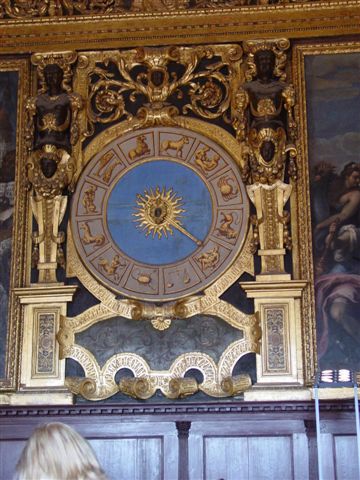
Interesting Zodiac Calendar in the Doges Palace (Photo by Pauline Abbott)
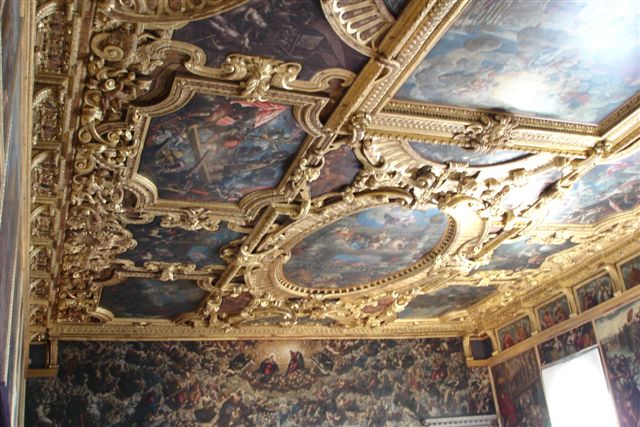
Doges Palace. One of the largest meeting rooms in Europe. The painting, "Paradise" at the end done by Veronese is the largest oil on canvas painting in the world. This room covers about an acre.
Near the end of our exploration of the palace we crossed over the Bridge of Sighs and toured the prison. The bridge was so named because prisoners were taken across this bridge, after receiving judgment in the court, to their cells. This walk from the palace to the prison represents one of the greatest contrasts imaginable, the palace being beautiful and ostentatious and the prison being about as bad and depressing as it can get. I was not inclined to spend much time in this depressing place. You could almost feel the presence of the spirits of the hundreds of men who suffered unspeakable pain and suffering in these dungeons.
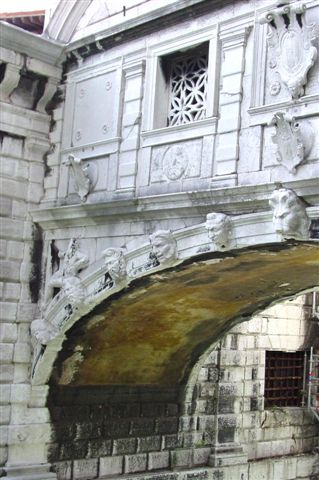
Close-up of the Bridge of Sighs taken from the Doges Palace. The bridge enters the prison at this point.
After about three hours in Doges Castle we rejoined Chris and Elizabeth and headed for an unusual spiral staircase on a home named Bovolo that I had seen in a tour book. On the way we stopped in one of the many local cafeterias for lunch. I like this kind of eating in Venice best since one can see what one is getting before ordering, and the prices seemed much more reasonable. I had the feeling that this is how most Venetians eat.
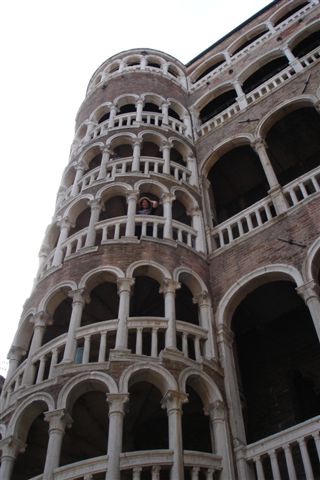
The Bovolo Home. Look closely and you can see Pauline about half way up. There is a splendid view from the top.
After climbing the spiral staircase and marveling at the architecture we headed off in different directions. Chris and Elizabeth had chosen to see the annual gondola regatta, a race that would take place on the Grand Canal at 4 PM. I could wait no longer; I wanted to sit somewhere and paint some of this amazing scenery. I searched for a spot where I could sit as inconspicuously as possible out of the normal tourist traffic. After half an hour of scouting, I selected a quiet spot overlooking the Bridge of Sighs in a spot that seemed much less traveled. In a few minutes I was immersed in my timeless, right brain in a deep meditation, totally unaware of my immediate environment. At some point, perhaps fifteen minutes later, I became aware that the corner had become a Grand Central Station crowded with gondolas, boats, and tourists hanging over my shoulder to see what I was doing. After a few minutes of distraction I managed to disregard the cacophony and continue in my own world.
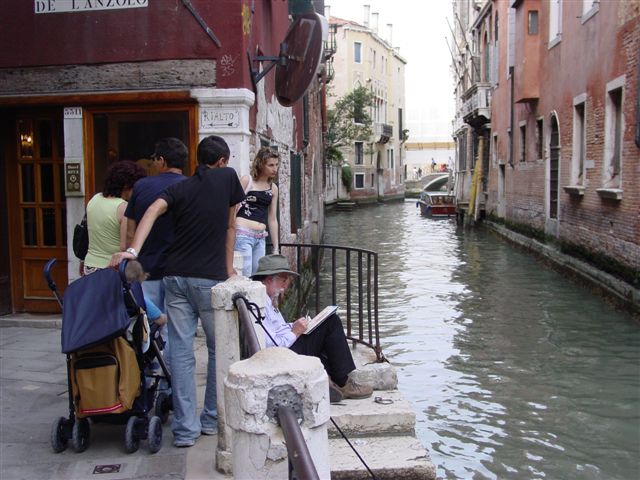
Painting one of the zillions of beautiful scenes in Venice. After a while, I got used to tourists constantly hanging over my shoulder to see if I was any good. (Photo by Pauline Abbott)
Time flies in Venice and nightfall came. Everyone was happy with his day. The regatta had been spectacular and I was pleased with my painting experience. "We must have coffee and apple pie in Florians before we leave Venice," all exclaimed, so with weather cooperating nicely, we took our seats at a sidewalk table in front of the orchestra. Two similar orchestras compete for the business on San Marco Square, but Florian’s is the most famous. Presumably, this was the gathering place of the famous Venetians of yesteryear. Two cups of coffee and apple pie produced a bill of $70. Unless you just want to say you have had coffee at Florians, I suggest you stand behind the tables and enjoy the music for free.
Pauline and I still had things to do that were old hat to Chris and Elizabeth so on Monday morning we headed for the Academia, the largest collection of Venetian art in the world. Having become spoiled with seeing so much art in its intended public place, I felt serious doubts about enjoying a gallery visit. Galleries are like hospitals for homeless and sick art, whereas the art in a church belongs there, often haven been painted in place. I was somewhat relieved to learn that some of the art in the Academia was painted for that place since a part of the gallery was once a school. To make the visit more meaningful, I selected seven paintings in the gallery to see. These were:
Portrait of a Man by Leonardo Lotto, one of my favorite Venetian artists. This painting was one of Lotto’s early paintings. I think it is the best painting in the Academia Gallery.
The Last Supper/Party at Lot’s Home, by Paolo Veronese. This painting is particularly intriguing since it was originally painted as Veronese’s interpretation of The Last Supper. Being interpreted by the church as being blasphemous, Veronese was ordered to destroy it or be burned at the stake. Ultimately, with some negotiation, the inquisition settled after Veronese agreed to change the name of the painting to Party at Lot’s Home. It is pretty easy to see why the painting upset the religious zealots.
The Tempest by Bellini, a painting that critiques have attempted to understand for centuries. Pauline and I each had our own very different interpretations, which seemed pretty obvious to us.
Presentation of the Virgin, by Titian. I have never seen a Titian that didn’t make me feel pretty incompetent as an artist. I figure that this is the reason why so many upcoming artists latch on to modern art and choose to do that instead of compete with guys like Titian.
Three special Tintoretto's. By now Tintoretto had become a real friend of mine. You simply can’t come away from Venice without discovering what a master Tintoretto was.
I studied each of the paintings, then did a 15 minute walk through the remainder of the gallery and left. I was almost happy to discover that a third of the gallery was closed off temporarily. This was the perfect way for me to see Academia without getting totally saturated with art. We rejoined Chris and Elizabeth at 2 PM and had lunch at the Academia Bridge, where, sitting outside, we had an excellent view of the Grand Canal.
We crossed the bridge and made our way to Miracoli, a church of miracles, where a famous painting of the Madonna is said to have healing powers. The Miracoli Church is made of white marble, and sitting on the edge of a canal, provides a spectacular reflection in the water and backed by buildings with beautiful flower boxes, makes one of the most spectacular scenes I had scene all day. It is not difficult to see why every artist wants to spend time in Venice. It was at Miracoli that I discovered another painting of Christ that was even more magic to me than the healing painting of the Madonna. If I stared at the painting long enough, I would see Jesus begin to wink at me.
We moved from Miracoli to a Rococo, Jesuit church near the far side of the island, where the interior designers went way over the edge. Every square inch has some form of sculpture. It will take your senses into overload.
Next we ventured in the SanGiovanni and San Paolo church, which not only has some great art, it also had a Leonardo Lotto that I wanted to see. Before this trip I had never seen a Lotto in its original place of origin. Sitting adjacent to the church is the Venice hospital, which could easily be mistaken for another beautiful church. Parked in the canal beside the church were about a dozen ambulance boats, ready for action. After this visit we stopped at an ice cream parlor across the street and had a delicious dessert sitting in the beautiful square.
On the way back to the hotel we continued our search for the perfect glass statue and we found it on a nearby square. According to my general rule of buying art, we decided not to do anything hasty, never buying on first sight, so we left the glass shop and continued to shop, making sure nothing else yanked out and grabbed us. We saw nothing we liked better in the remainder of the trip.
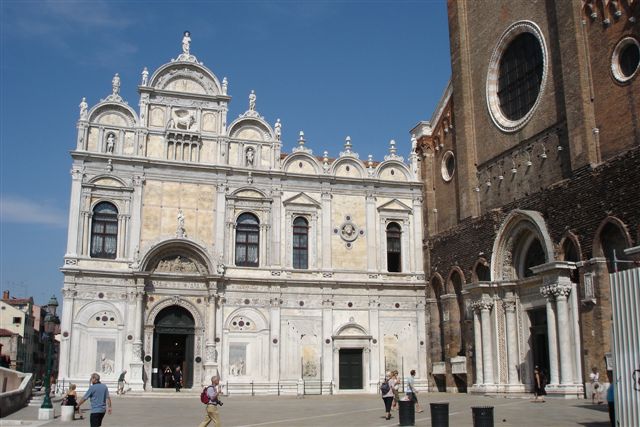
St. Giovanni and St. Paolo Church (right) and Venice Hospital (Left). Taken from the ice cream parlor.
We had chosen this evening for our gondola ride and we shopped around to make our selection. At one point we were told that we had to choose from the front of the line of gondoliers. Elizabeth insisted on all details of the gondola trip to be proper, and the first gondolier was not properly dressed with hat and striped shirt, so she turned him down. Soon after we left, the second gondolier chased after us and offered his services. He, being an enthusiastic gondolier in addition to his proper dress, passed our requirements, so we hired him. Later he told us that he had taken over the business from his father, but that large companies had begun buying up the gondolier licenses and that the tradition was suffering.
We were glad that we held out. This guy was good. He took us on an hour’s tour of tiny canals amongst buildings and churches we had passed by during the day. His knowledge of Venice, his enthusiasm and his good English made our trip extra special. Everything seemed so quiet and peaceful as we moved silently between residences and under many bridges…..and romantic. It is impossible not to kiss ones lady in such an environment. At one point we entered the Grand Canal, and we were all amazed at the quietness of this canal, which earlier in the day had been almost in total gridlock with every variety of noise making boat. Amazingly, we were practically alone on the Grand Canal. Some of the gondolas come equipped with a singer. We sort of felt like that would take away from the intimacy and quietness of the trip so we passed on that idea.
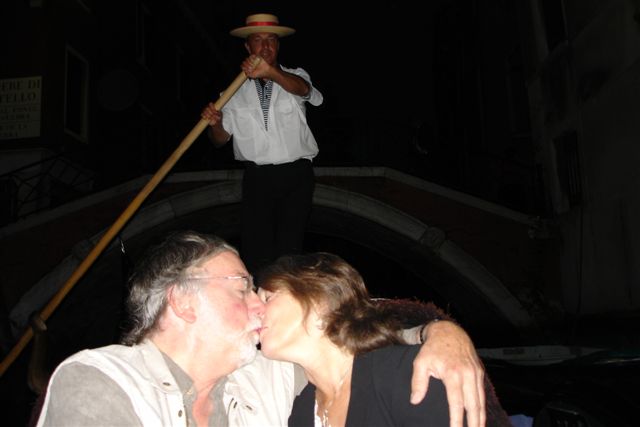
Like I said………Romantic. Impossible not to kiss one’s lady.
After our gondola ride everyone was ready for a seafood dinner. We sat out to choose a restaurant at random. Our main requirement was that we get seating outside in a garden part of the restaurant. A waiter coaxed us in by telling us he would give us free wine until the perfect table in the garden became available. We accepted his offer. We all were happy with the wine, the food, and the ambiance. He had us a great table before we finished off the first bottle.
.jpg)
The wine is free while we wait on a table in the garden.
We decided that on our last day, Tuesday, we would mostly just hang out and not attempt to jam in a lot of activities. Even so, we set out early to see the fish market at its best. This required a walk across Rialto Bridge. The market is a lively place with every variety of fish and crab spread over a few acres along the Grand Canal. Near the market, we passed an artist doing a large oil painting of the market place. I envied him for a while, and then moved on to catch up with the others. The locals come here to purchase fish, vegetables, and flowers. The air is so full of strong smells that one could purchase whatever he needs with eyes closed. We saw live sea creatures that no one could name.
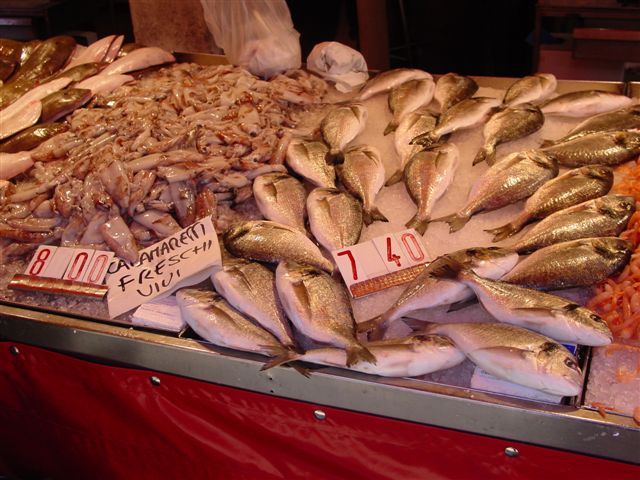
Fresh caught fish in the market (Photo by Pauline Abbott)
After a tour of the market we split into various interest groups. I chose to sit along a canal and paint again. Again I selected a spot on a side street/canal overlooking a picturesque café and a bridge. Once again, not long after I sat down, the place seemed to get busy and I had tourists gathering around to see what I was doing. Eventually, I managed to screen them out of my consciousness and just enjoyed painting, something I would never tire of doing in such an amazing place.
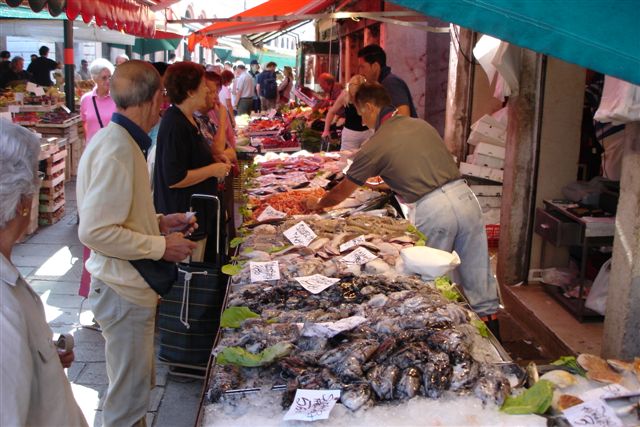
The Market place
We assembled again for a late lunch near the Rialto Bridge over looking the Grand Canal. Elizabeth had stayed longer at the market and purchase large bags of mushrooms to take back to England. Pauline had found some more angels and egg cups. Chris had almost filled the memory stick in his camera.
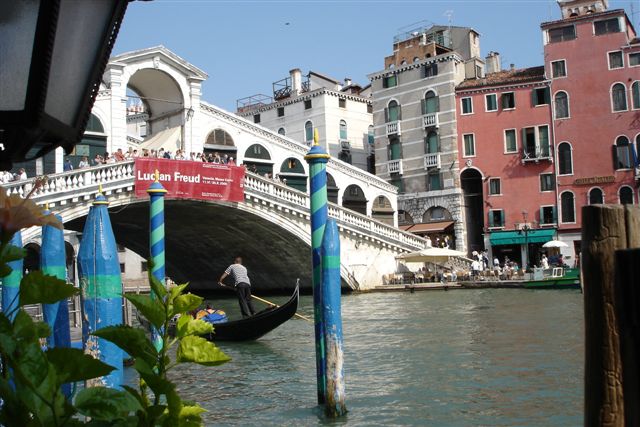
View from our lunch table near Rialto Bridge
After lunch we had just enough time to return to the square where we had found the perfect statue to make our purchase. After some negotiation with the storeowner, we accepted his offer and waited as he packed it securely in bubble wrap for the trip. I couldn’t resist carrying it back myself. The storeowner had told us that he managed to sell the entire output of this particular master, whose work we really loved. Our timing could not have been better, because this very master entered the store with his latest offerings to the dealer, who immediately placed them on his shelves and proceeded to introduce us. The artist was seemed very happy to see someone who liked his work.
Now it was time to return to the hotel to retrieve our baggage and order a taxi back to the airport. This time the taxi pulled right up to the hotel and the four of us mounted a speedboat with our luggage, which was somewhat heavier than when we arrived in Venice.
The boat worked its way right through the middle of the island taking the shortest path, and we passed San Giovanni and San Paolo Church, the hospital and a dozen ambulance boats along the canal before emerging from the opposite side of the island and heading out to sea and back past the cemetery. The return to the airport was much quicker than the Vaporetto trip.
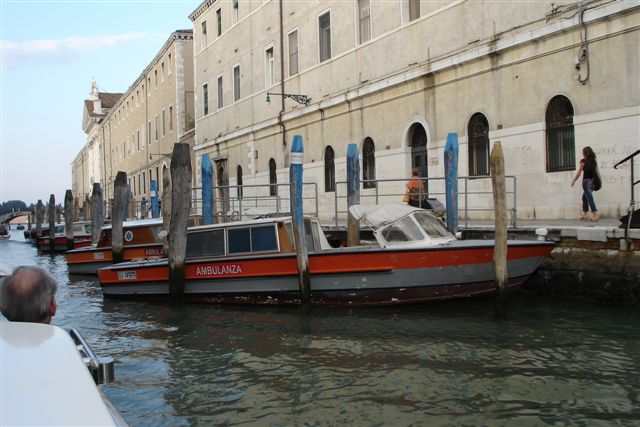
We all knew that we would come back as soon as we had the opportunity. Within a few weeks I discovered that the next meeting of the Aeroballistics Range Association meeting, which I attend each year, would be held in Venice in 2007. The universe had already responded to my wishes to come back soon.
